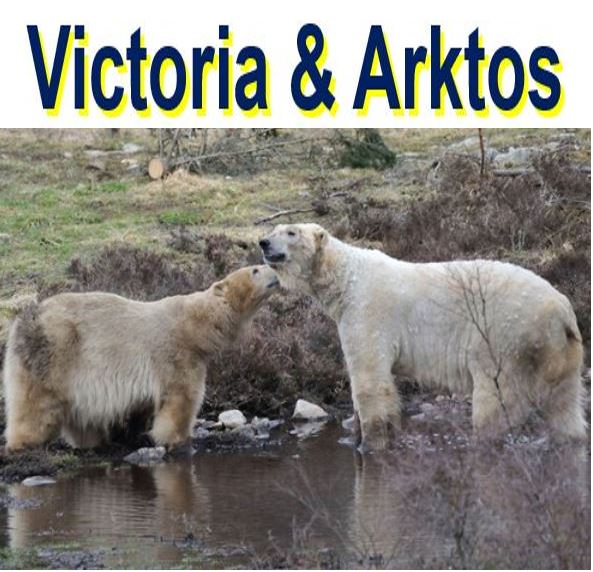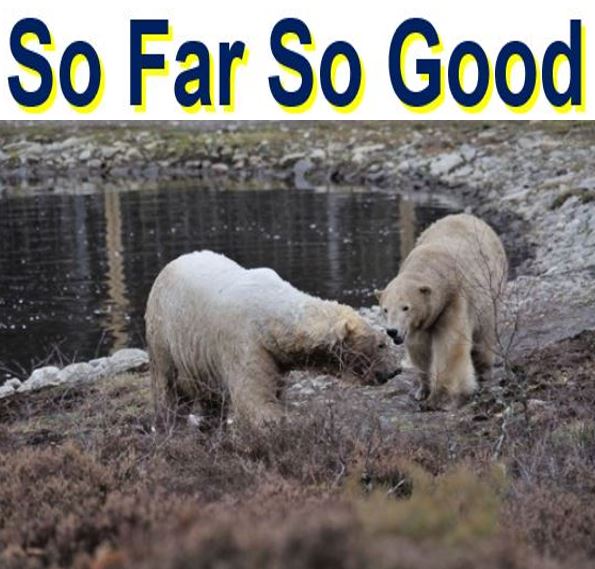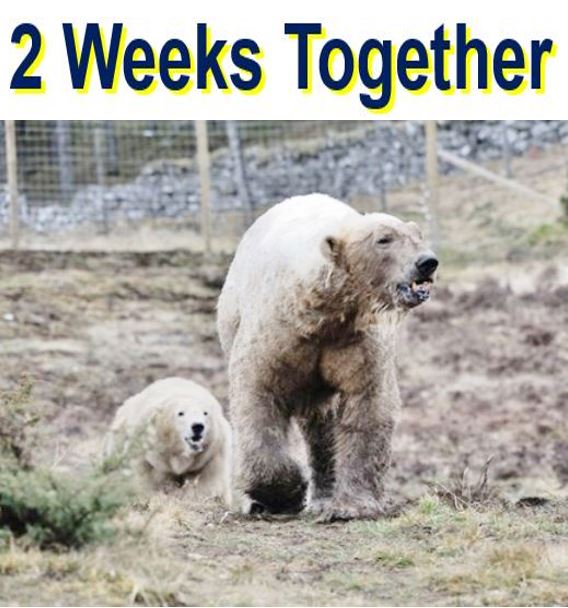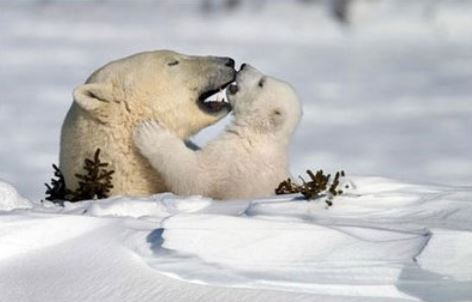Scottish polar bear love is in the air, keepers at Scotland’s Highland Wildlife Park report, with Arktos and Victoria hopefully producing lots of cubs. The two polar bears were successfully introduced, and if everything goes to plan, they should soon be breeding. They took to each other immediately and appear to have bonded strongly.
The polar bear breeding program at RZSS (Royal Zoological Society of Scotland) Highland Wildlife Park has passed an important milestone – after all the behaviours indicated that Victoria has come into estrus (is on heat) – Victoria and Arktos were successfully introduced.
Arktos, the oldest of the Park’s two male polar bears, was transported the short one-mile distance across the Park on 15th March and moved into a specially-designed enclosure adjacent to Victoria. Victoria is the only female polar bear in the UK.
 The mutual attraction began as soon as Victoria (left) and Arktos saw each other. Hopefully, this strong bond they have developed will lead to polar bear cubs. (Image: highlandwildlifepark.org.uk)
The mutual attraction began as soon as Victoria (left) and Arktos saw each other. Hopefully, this strong bond they have developed will lead to polar bear cubs. (Image: highlandwildlifepark.org.uk)
Bears clearly attracted to each other
The keepers were overjoyed to see that the two bears took to each other immediately, with lots of vocalisations, head-bobbing and bouncing.
They clearly liked each other straight away, the keepers said, adding that the two bears slept at the fence line and repeatedly tried to touch each other.
Four days later, on 19th March, the two bears had their first proper meeting with no fence chaperone – Arktos went to live temporarily in Victoria’s enclosure.
Over the next week or two, they will live together 24 hours each day, as would occur naturally in the wild. The keepers say Victoria and Arktos have already mated several times.
 Victoria is on heat, they have mated several times – so far so good. Over the next few weeks we shall see whether the ultimate aim of this breeding programme – polar bear cubs – has been achieved. (Image: highlandwildlifepark.org.uk)
Victoria is on heat, they have mated several times – so far so good. Over the next few weeks we shall see whether the ultimate aim of this breeding programme – polar bear cubs – has been achieved. (Image: highlandwildlifepark.org.uk)
Bears appear to have bonded well
They are sleeping side-by-side, following each other around all the time, and resting their heads on each other – these are all clear signs that they have bonded strongly.
Head Carnivore Keeper at RZSS Highland Wildlife Park, Vickie Larkin, said:
“It’s fantastic news and their introduction couldn’t have gone any better. Both polar bears have really warmed to each other and all the signs are really positive. From the first moment they met, Arktos has been really gentle with Victoria and their bond has been immediate.”
“Polar bear breeding is inherently complex as the species are induced ovulators, meaning that the female only releases an egg after initial mating occurs; they also practice delayed implantation, where the egg doesn’t implant into the uterine wall until some months later If successful, Victoria will not fall pregnant until August to September time.”
“Other key stages are her entering the birthing den in October to November and potentially giving birth in December to January. Any cubs would then not come out of the birthing den until March to April 2017.”
 Arktus and Victoria will spend the next week or two together. (Image: highlandwildlifepark.org.uk)
Arktus and Victoria will spend the next week or two together. (Image: highlandwildlifepark.org.uk)
CEO of the Royal Zoological Society of Scotland, Chris West, said regarding polar bear breeding in the UK:
“Listed as Vulnerable on the IUCN Red List of endangered species, this is the first time in 25 years that polar bear breeding has successfully taken place on UK soil. This is something to be celebrated.”
“At RZSS we have a duty to help protect the future of this magnificent species, and our polar bears benefit from the largest enclosures in the world and expert husbandry that is second to none.”
 A polar bear mother can give birth to up to three cubs – usually two. In the wild, cubs stay with their mothers for about 20 months. During that time she teaches them to hunt and how to live in the cold Arctic environment. In the high Arctic, where life is tougher, the cubs usually stay with their mother for another year. (Image: goodnature.nathab.com)
A polar bear mother can give birth to up to three cubs – usually two. In the wild, cubs stay with their mothers for about 20 months. During that time she teaches them to hunt and how to live in the cold Arctic environment. In the high Arctic, where life is tougher, the cubs usually stay with their mother for another year. (Image: goodnature.nathab.com)
“Climate change is predicted to cause further sea-ice losses and horrifying statistics estimate that the global population of polar bears could decline by over 30% in just three generations*. Any cubs born to Victoria will help to populate a healthy ex-situ ‘ark’ of polar bears to give conservationists as many future options as possible.”
“As we always say, in an ideal world, conservation would happen primarily in the wild but, when issues exist in the wild, the next best thing is a combined in-situ and ex-situ approach that has the goal of one day restoring or augmenting wild populations.”
Video – Victoria and Arktos introduced
As this RZSS Highland Wildlife Park video shows, Arktos and Victoria were successfully introduced to each other during the weekend.
